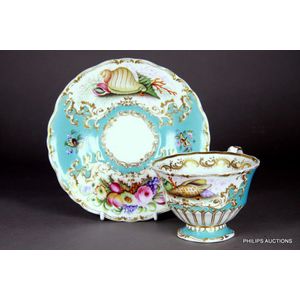Copeland & Garrett Felspar Porcelain Cup & Saucer, 1835
You must be a subscriber, and be logged in to view price and dealer details.
Subscribe Now to view actual auction price for this item
When you subscribe, you have the option of setting the currency in which to display prices to $Au, $US, $NZ or Stg.
- Lappet Decoration - In the context of furniture, ceramics, and oriental wares, the word "lappet" refers to a decorative motif that consists of a repeated pattern of stylized or abstracted "lappets."
A lappet in this context is a decorative element that resembles a small, hanging flap of cloth or fabric, but rather are stylized patterns that resemble the shapes and folds of lappets. They can be found on a wide range of objects, including furniture, vases, bowls, and plates.
Lappet decoration can take many different forms, but typically consists of a series of semi-circular or pointed shapes that are repeated in a continuous pattern. The shapes may be simple or highly ornate and may be arranged in a regular or irregular pattern. The design may also include other decorative elements, such as floral or foliate motifs.
Lappet decoration is often associated with Asian design traditions, and can be found on a wide range of objects from these regions, including Chinese porcelain, where lappet decoration is often used as a symbol of abundance and prosperity, and is believed to have protective and auspicious qualities. - Circa - A Latin term meaning 'about', often used in the antique trade to give an approximate date for the piece, usually considered to be five years on either side of the circa year. Thus, circa 1900 means the piece was made about 1900, probably between 1895 and 1905. The expression is sometimes abbreviated to c.1900.
- Feldspar (glaze on Porcelain) - A feldspar glaze on porcelain is made from feldspar, a mineral that when melted and mixed with other ingredients creates a glossy, glass-like coating. When applied to porcelain, the feldspar glaze provides a hard, durable and protective surface that is resistant to wear, staining and other forms of damage. Additionally, feldspar glazes can also enhance the appearance of porcelain by creating a smooth, even surface with a range of colours and finishes.
This item has been included into following indexes:
Visually similar items

A Royal Crown Derby 'Royal Pinxton roses' Sandwich plate, 1981, pattern a 1155, with a fluted edge and small foliate handles, with loose sprays of pink roses with gold foliage, the gilt tipped rims also with raised dots and scrolls; backstamps underside an

Dresden plate with floral centre

Four various early china items. Rockingham type cup and saucer with pheasant decoration; Imari jug and bowl

An early Spode Japanese pattern Chestnut basket and stand, 1802-5, pattern 287, a lattice weave basket and stand with a conforming pierced rim, decorated with reserves of patterns, whimsical dragons, trailing blossoms and 'Mons', centred with a large styli
